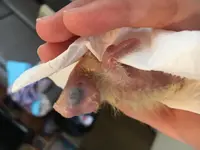
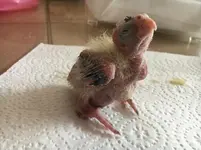
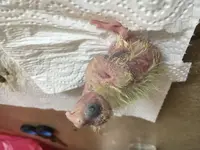
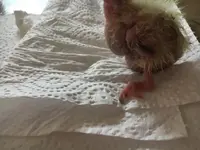
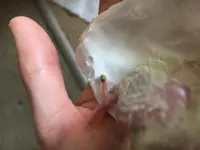
Hello,
I am relatively new to cockatiel chick raising and currently have three chicks who are at least 1 week old. I previously had 5, but 2 had unfortunately passed away in the nest. I didn't know at the time that it was important to clean out the nest, as I was under the impression that you should never touch a bird's nest or the chicks until they leave the nest naturally. When I took the deceased chicks out, I decided to clean the nest anyway, as there were maggots and a lot of faeces and I didn't want to make them all ill. I now know that it's sensible to clean the next every few days.
In the meantime, I noticed there was one chick who was a lot weaker than the others and decided to take him for hand raising, as I had a feeling he might have passed away if I left him. He's now been inside for the past week and he weighs 30 grams, is opening his eyes and starting to grow pinfeathers. I did have a mishap with the formula, as I realised it was much thinner than it needed to be and he wasn't getting enough food, but ever since I've fixed that up he's been rapidly gaining weight and growing well. Although I still notice he's not as lively as the other two chicks.
The chicks, however, did have some faeces attached to their feet and areas near their tails (tails havent grown yet), so I've been spending the last few days using some warm water to get it off them. I've only now just been able to completely remove it all. Because it was on their feet, I have a feeling it was definitely affecting their ability to walk. One of the chicks - the middle chick - appears to have splayed feet and I'm not sure what I can do to help this. This chick also still has its eyes closed and one eye in particular doesn't look like it's opening at all (both eyes had food or faeces on them and I had wiped it away, but there's still some little marks of something on the one that looks faulty.
The hand-reared chick also has a ball of faeces on his feet which I tried to remove, but he started screaming and I realised his toe had started to bleed. I'm not sure whether I should keep trying to remove it or whether there's something else I'm meant to be doing.
The eldest chick is 40 grams, the middle chick 27 grams and the youngest hand-reared chick is 30 grams. Not sure if the middle-chick is too thin or my chick is just fat, as he does like his food.
I've attached some photos of each of the chicks for reference. I'd also just like to know if they look healthy or not.
The pinker one with eyes with some formula stuck to him (trying to get it off but he doesn't like being wiped much) is the hand reared one. The eldest is the one with the most advanced pinfeathers and spikey head and the middle-child is the splayed-foot one.
Thank you so much for reading through the long message and the help!


